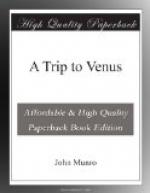“Well, what do you make of it?”
The voice recalled me to myself, and I began to scrutinise the dim and shadowy border of the terminator for the feeblest ray of light, but all in vain.
“I can’t see any ‘luminous projection’; but what a magnificent object in the telescope!”
“It is indeed,” rejoined the professor, “and though we have not many opportunities of seeing it, we know it better than the other planets, and almost as well as the moon. Its features have been carefully mapped like those of the moon, and christened after celebrated astronomers.”
“Yourself included, I hope.”
“No, sir; I have not that honour. It is true that a man I know, an enthusiastic amateur in astronomy, dubbed a lot of holes and corners in the moon after his private friends and acquaintances, myself amongst them: ‘Snook’s Crater,’ ‘Smith’s Bottom,’ ‘Tiddler’s Cove,’ and so on; but I regret to say the authorities declined to sanction his nomenclature.”
“I presume that bright spot on the Southern limb is one of the polar ice-caps,” said I, still keeping my eye on the planet.
“Yes,” replied the professor, “and they are seen to wax and wane in winter and summer. The reddish-yellow tracts are doubtless continents of an ochrey soil; and not, as some think, of a ruddy vegetation. The greenish-grey patches are probably seas and lakes. The land and water are better mixed on Mars than on the earth—a fact which tends to equalise the climate. There is a belt of continents round the equator: ‘Copernicus,’ ‘Galileo,’ ‘Dawes,’ and others, having long winding lakes and inlets. These are separated by narrow seas from other islands on the north or south, such as: ’Haze Land, ‘Storm Land,’ and so forth, which occupy what we should call the temperate zones, beneath the poles; but I suspect they are frigid enough. If you look closely you will see some narrow streaks crossing the continents like fractures. These are the famous ‘Canals’ of Schiaparelli, who discovered (and I wish I had his eyes) that many of them were ‘doubled,’ that is, had another canal alongside. Some of these are nearly 2,000 miles long, by fifty miles broad, and 300 miles apart.”
“That beats the Suez Canal.”
“I am afraid they are not artificial. The doubling is chiefly observed at the vernal equinox, our month of May, and is perhaps due to spring floods, or vegetation in valleys of the like trend, as we find in Siberia. The massing of clouds or mists will account for the peculiar whiteness at the edge of the limb, and an occasional veiling of the landscape.”
While he spoke, my attention was suddenly arrested by a vivid point of light which appeared on the dark side of the terminator, and south of the equator.
“Hallo!” I exclaimed, involuntarily. “There’s a light!”
“Really!” responded Gazen, in a tone of surprise, not unmingled with doubt. “Are you sure?”




